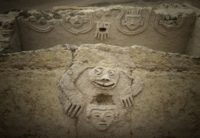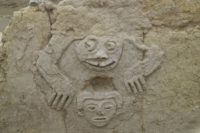 The 3,800-year-old relief with the emoticon-like seed discovered last year at the ancient site of Vichama in Peru has a new-found friend: a toad with anthropomorphic hands on each side of a disembodied head. This tableau is on a small wall in front of the larger frieze, but they share a common theme. The large frieze on the nine-foot wall behind this ones featured four disembodied human heads with two serpents winding above them that meet over the anthropomorphic seed putting down roots and looking really happy about it.
The 3,800-year-old relief with the emoticon-like seed discovered last year at the ancient site of Vichama in Peru has a new-found friend: a toad with anthropomorphic hands on each side of a disembodied head. This tableau is on a small wall in front of the larger frieze, but they share a common theme. The large frieze on the nine-foot wall behind this ones featured four disembodied human heads with two serpents winding above them that meet over the anthropomorphic seed putting down roots and looking really happy about it.
Snakes and toads both represented water in the Norte Chico civilization which occupied Vichama about 1800 B.C., a period afflicted by a succession of droughts that ultimately lead to the abandonment of Caral, Norte Chico culture’s captial and its largest and oldest city. Vichama, thanks to its proximity to the ocean and the freshwater Huara River, outlasted it by centuries. The city was abandoned around 1500 B.C.
Dr Ruth Shady Solís, director of the Caral Archaeological Zone (ZAC), believes the scene represents the “arrival of water” through rainfall.
She says that in Andean civilisation, toads represented water and says the face below it represents humans waiting for rainfall to give continuity of life. […]
Researchers said the sculptures would probably have been produced in a period of scarcity and famine.
Tatiana Abad, another archaeologist at the site, said at a news conference on Monday the carving represented a time of “crisis” for the people living there.
 There are some differences between the figures on the background and foreground relief. The toad on the newly-discovered wall has PacMan-like pupils that look due east. The human face has the east side eye open and the west side one closed. (The heads on the long frieze all have closed eyes.) That persistent unidirectional strabismus may be a reference to the Andes which like to the east of Vichama and are the source of fresh water for the coast.
There are some differences between the figures on the background and foreground relief. The toad on the newly-discovered wall has PacMan-like pupils that look due east. The human face has the east side eye open and the west side one closed. (The heads on the long frieze all have closed eyes.) That persistent unidirectional strabismus may be a reference to the Andes which like to the east of Vichama and are the source of fresh water for the coast.
The friezes were found in the anteroom of a large ceremonial hall that was almost 10,000 square feet in total area. That structure overlooked the agricultural fields of the Huaura River valley. The building was used for centuries and was constantly being remodeled, repaired and redesigned. Several important sculptural friezes have been found since excavations began in 2007. The motif of famine is addressed in many of them even more directly, depicting anthropomorphic characters with empty stomachs, some dead, other engaged in a ritual dance. Archaeologists have also discovered 22 architectural complexes including public buildings, plazas — one circular sunken one — and residential dwellings.